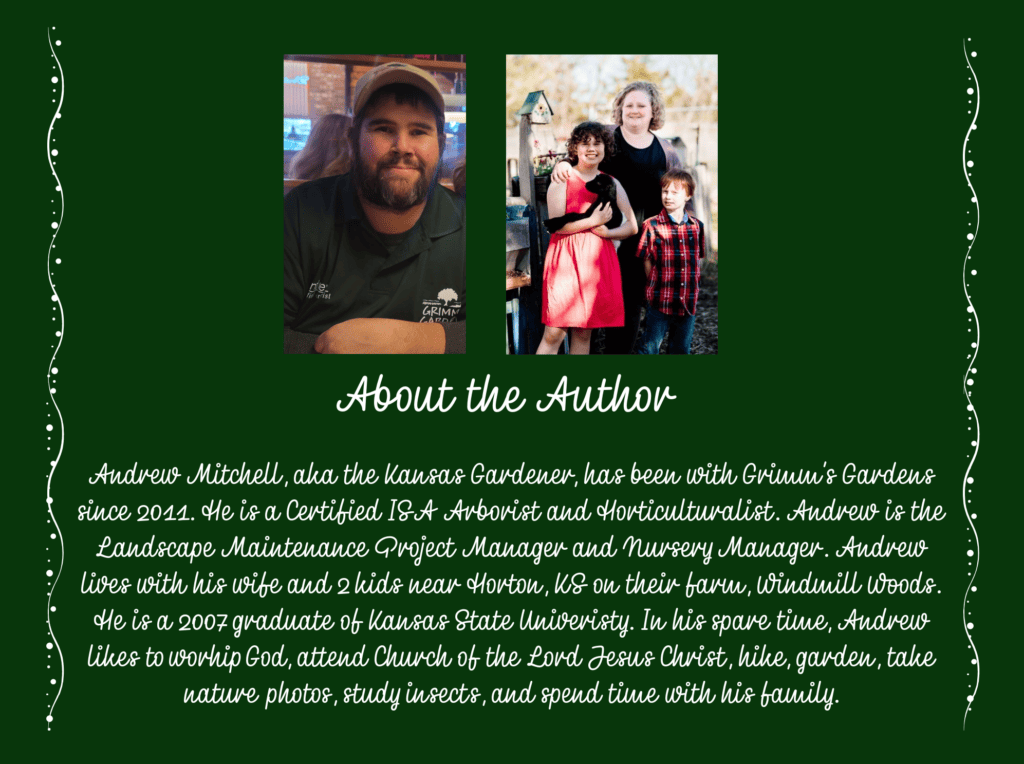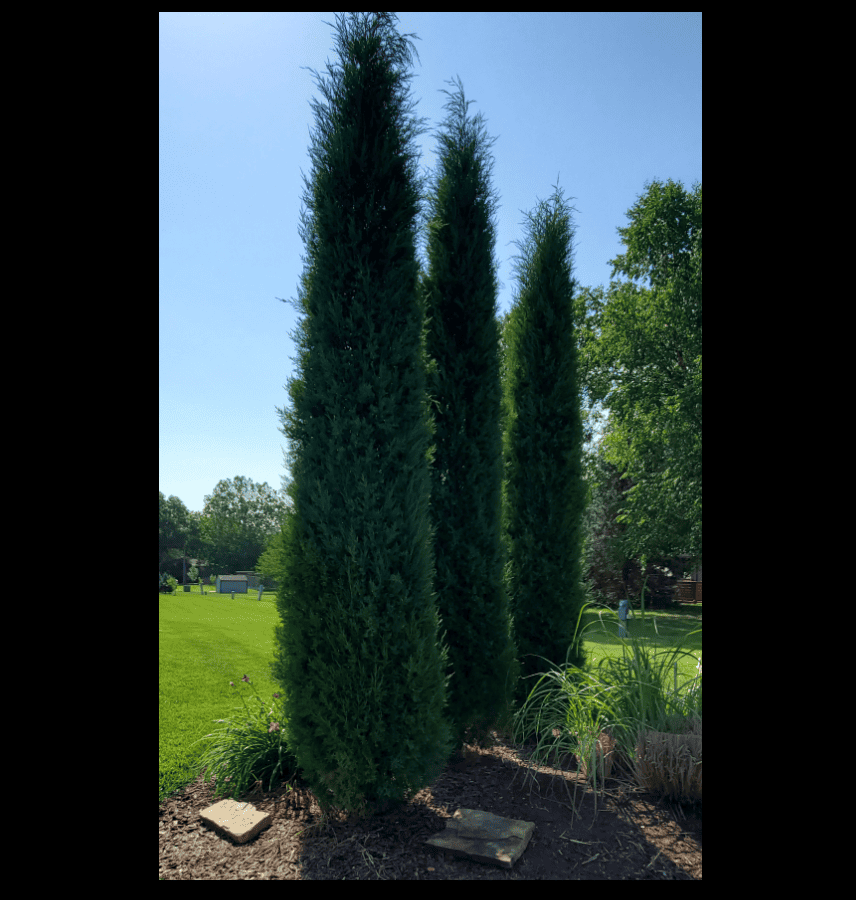Evergreen plants can be anything that does not lose its leaves in winter. That would include groundcovers, perennials, shrubs, vines, and trees. But to keep it modest, I will go over some of the trees and shrubs which are evergreen in our region. These are some of the best choices for our area. I will also discuss some maintenance, such as pruning, pests, and diseases.
There are many different types of evergreens. There are broadleaf evergreens, such as holly, magnolia, and boxwood. Or there are needled evergreens such as pine, spruce, and fir. Some, like juniper and arborvitae do not fit into either category, because their “needles” are rounded or flattened in large clusters. And not all evergreens are conifers. What is a conifer? Conifers are a group of cone-bearing seed plants, a subset of gymnosperms.
Trees
I will go over my top 5 and bottom 5 for trees and shrubs which are evergreen. The top 5 are less likely to be bothered by pests or diseases, and are adapted better to our heat and humidity in summer. And our cold temps in winter. We may live in Zone 5 to 6b, but it can dip into the negative teens from time to time. For evergreen plants, it is the loss of humidity and cold in winter which really gives them problems, more so than the heat of summer.
Top 5 Evergreen Trees for the Central Great Plains
1. Eastern White Pine – Pinus strobus
There are no native evergreen trees in Kansas. No, not even the lowly eastern red cedar. But the white pine adapts the best to our heat and cold, without too many problems. They make great windbreak trees, and you can find whole plantations of them in northeast Kansas. And there are some unique weeping cultivars which are quite ornamental. Eastern white pine has soft, long needles in clusters of 5. the cones are large, 4 to 8 inches long. Besides a windbreak tree, the eastern white pine can be planted in the landscape or even sheared yearly as a hedge.
Pests include pine sawfly, evergreen bagworm moth, and pine scale. Yellow-bellied sapsuckers may feed on the tree. If you see holes which appear to be perfect drill holes lined concentrically on the trunk, think sapsuckers. And if you live in a rural area, deer browsing may also be a problem. Most of the trees in our area need no fertilization, but watch out for iron chlorosis on high pH soils.

2. Norway Spruce – Picea abies
Surprisingly, my number 2 is not even native to North America. I try to pick native plants over nonnatives as much as possible. But I cannot do so here. The Norway spruce is an evergreen tree which just likes our climate better. Because we live in an extreme landscape where climates collide, the trees have to be tough too. That is probably why we have no native evergreen trees.
Norway spruce has short, dark green needles whose branches begin to droop as they age. The size for droopiness seems to be around 10 feet. We have some very large old specimens of Norway spruce in the area, some over 70 feet tall. The hardest thing about growing Norway spruce here is that is can be difficult to get started when young. Watering is very important for the first couple of years.
Pest problems include evergreen bagworm moth (rarely) and spruce spider mite. Rhizospaera needle cast is about the only disease which is a problem in our area, but it is more common on Colorado spruce.

3. Black Hills Spruce – Picea glauca
Despite being native much farther to the north of Kansas and Nebraska, the Black Hills spruce grows well here. It is shorter and more compact than the Norway spruce. However, the needles are the same dark green. It is similar in looks to the Colorado green spruce, but I rarely see the same issues as that tree. The Black Hills spruce is actually a subspecies of white spruce.
Pests include bagworms (rarely), spruce spider mite, and spruce aphids. None of these are considered serious pests of Black Hills spruce in the Central Great Plains region. Rhizospaera needle cast and phytophthora may affect mature trees.
4. Douglas-Fir – Pseudotsuga menziesii
Not a true fir nor a true hemlock (Tsuga), the Douglas-fir is in its own genus, with 5 other species, all native to the western US and Canada. It is a member of the pine family, and has needles which are flattened, like a fir. When younger, the trees resemble blue spruces, but get top heavy as they age. I think it is one of the more under-used tree in landscapes. But there are several older specimens in southeast Nebraska and Northeast Kansas.
Environmental or with scorch is the only problem Douglas-fir has in our region. I have yet to see either spider mites or bagworms be a problem.

5. Eastern Red Cedar – Juniperus virginiana
There are a lot of red cedar haters out there, especially in Kansas because of the prolific way in which it invades pastures. But if proper pasture management were practiced with burning and rotational grazing, it would never be an issue. Eastern red cedar is considered to be native in the state of Kansas, but I would disagree. I highly doubt it was even present 300 years ago in Southeast Kansas, where it is said to be native. I include it however because it does very well here. Red cedar grows quickly and lives for a long time, well over 100 years. It can be used as a windbreak tree or for hedges and screens.
Pests do include evergreen bagworm moths, deer browsing, and several native moth species. The juniper hairstreak butterfly does use it as a host plant, but without causing significant damage. It is prone to fungal root rots when we have extreme rain or moisture conditions. In 2019 we had excessive rainfall, almost double our yearly average, and lots of red cedar died in 2020 from root loss in 2019. It is also the alternate host for cedar-quince and cedar-apple rust, which cause detriment to our apples and pears.

Bottom 5 Evergreen Trees
Now, just cause these are in the bottom does not mean that you should not grow them. Go for it! I love some of these and they each have their place. But they are less adapted to our overall climate in this ecoregion, and usually need to be placed into a microclimate. Most of them I would not recommend for a windbreak or screen planting outside of town.
6. Colorado Blue Spruce – Picea pungens var. glauca
But why is it on the bottom of the list? Because, Colorado blue spruce are not well-suited for our region. Yes, I plant them myself and love them. But I expect them to be gone in less than 50 years. Now, I know that is a long time for most gardens, but I want trees that will be there for my grandkids, not just for me. There are just too many things that go wrong with Colorado blue spruce to put it in the top for evergreen trees.
Pests include spruce spider mite, two-spotted spider mite, evergreen bagworm moth, and several other moth species. Diseases include Rhizospaera needle cast, phytophthora root rot, and several other root rots. Too much rainfall or being placed in a spot that gets too wet is a problem for many of the evergreens, but especially so for the Colorado blue spruce.

7. American Holly – Ilex opaca
I have always loved American hollies. But they are not well suited for our region. It is native in the Southeastern US, and prefers soils that are a little bit more on the acidic side, as do all hollies. With our high pH soils, and heavy clay, American holly just does not do as well. Sure, there are some beautiful specimens across the region, but is not something you would use a s a windbreak or plant in masses.
While there is not many pests that bother holly, they are subject to scorch and leaf spots. Dieback from excessive moisture or cold is also an issue.

8. Concolor Fir – Abies concolor
This is possibly one of my most favorite evergreen trees, after the Douglas-fir. But the trouble we have with getting it started is enough of a deterrent to not plant a bunch of them. When young, they like to be high and dry, and not excessively watered, unlike most other trees. And they are prone to root diseases, whether or not they are planted high. This makes them undesirable as a windbreak species, or for screening. There are some absolutely stunning older specimens in the area, but I do not know of very many young ones.
They have many of the same issues as Douglas-fir, along with all the root rots.

9. Blue Atlas Cedar – Cedrus atlantica
I love the look of these. But I doubt if I will be able to grow them in my landscape. Partly because I do not have the space for a lot of evergreen trees (at least not right now) and partly because my microclimate does not suit them. I know of some very beautiful specimens in our region, but they get a zone or so higher than me by their microclimate. They are stunning trees, but need protection from our northwestern winter winds and extreme temperature swings. I have seen one drop all its needles from cold, and then re-leaf out in the spring. Amazing!
Blue atlas cedar can get evergreen bagworm moths and spider mites.
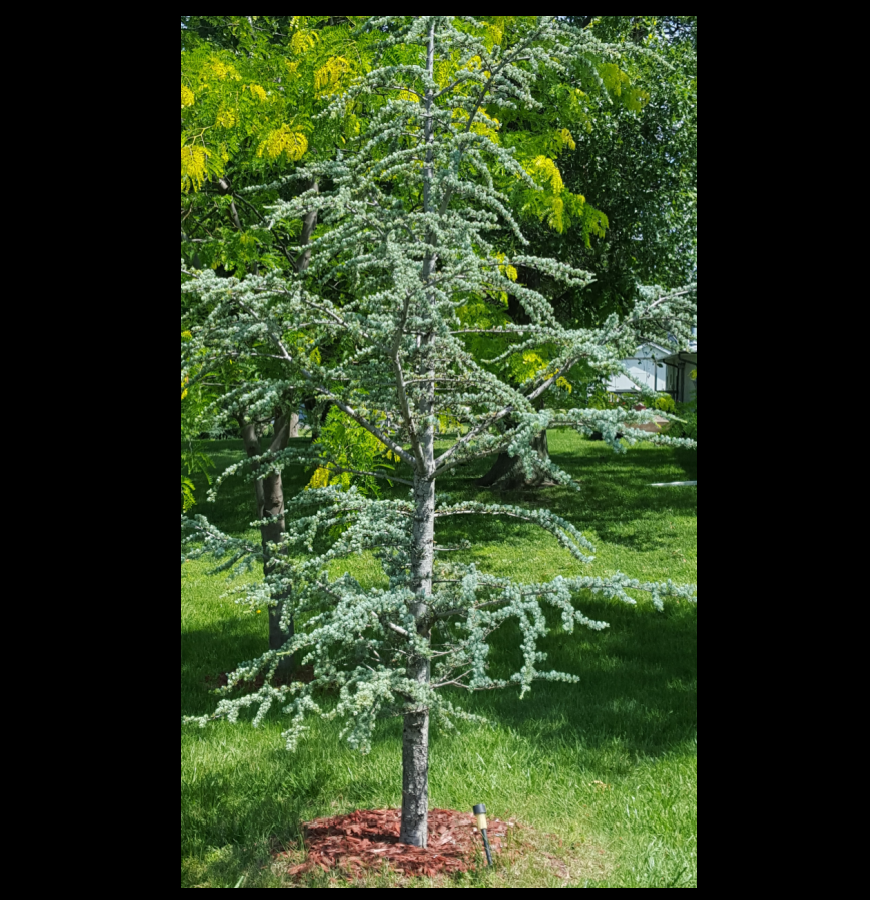
10. Southern Magnolia – Magnolia grandiflora
This is the only evergreen magnolia which will grow in our region. It is hardy to zone 5, but it can be temperamental in our cold winters. I know of several beautiful specimens in the area. And we had a nice one here at Grimm’s Gardens which we had to remove when we expanded our shop building. Like the blue atlas cedar, they are just not as suited to our winter winds and temperature drops. Otherwise, they would be an excellent choice as they have no major pests or diseases.
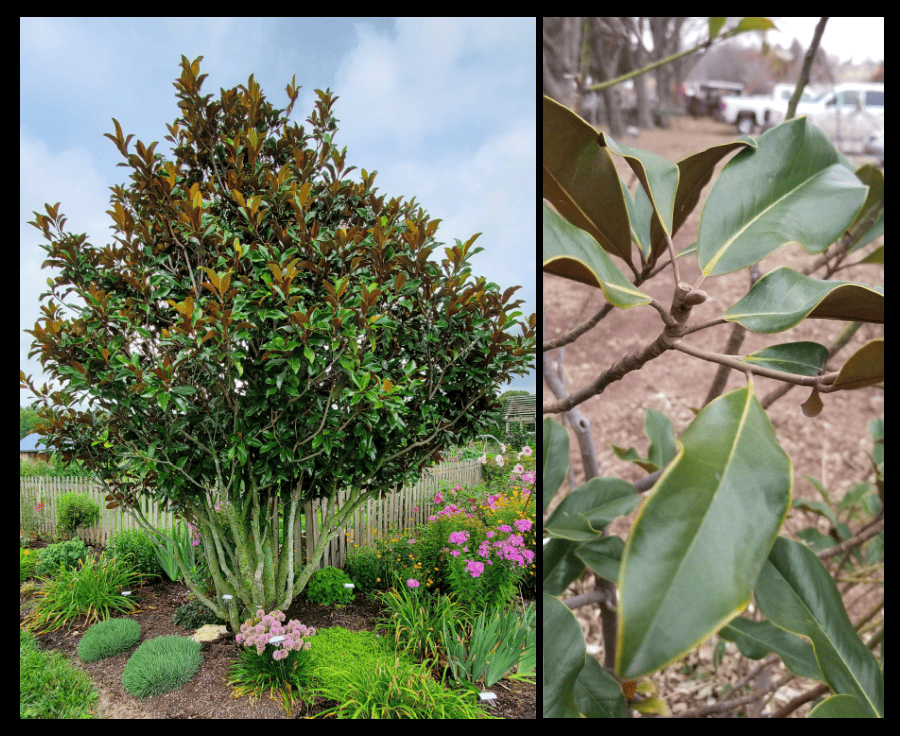
Shrubs
While there are a lot of different cultivars of the various evergreen shrubs that grow here, I am only concerned with the types of shrubs here. I will list some of the better cultivars for our area however under each type. Shrubs typically stay under 15 feet in height and can range from 1 to 10 feet wide, sometimes wider (junipers). Again, these are my top 5 and bottom 5, all of which will grow here. Some are just better suited for our area than others.
Top 5 Evergreen Shrubs
1. Yew – Taxus species
I do believe these are the toughest and most disease/pest resistant evergreen shrubs for the Central Great Plains. Not only are there a lot of option or cultivars to choose from, there is a lot of variety among them. They have dark leaves which look like needles and poisonous red fruits (actually the cone). So far, it is the only evergreen I have been able to chop the the ground and watch it come back to life. usually if you take off the life of an evergreen, it is dead.
There are no major pest or disease issues with yew. They can be sheared or pruned in May before the weather turns hot, or in November after the first hard freeze has occurred.
- ‘Densiformis’ grows 3 to 5 feet tall and wide.
- ‘Wardii’ grows 3 to 6 feet tall by 10 to 20 feet wide.
- ‘Hicks’ grows 6 to 15 feet tall by 6 to 10 feet wide.
- ‘Taunton’ grows 3 to 4 feet tall by 4 to 8 feet wide.
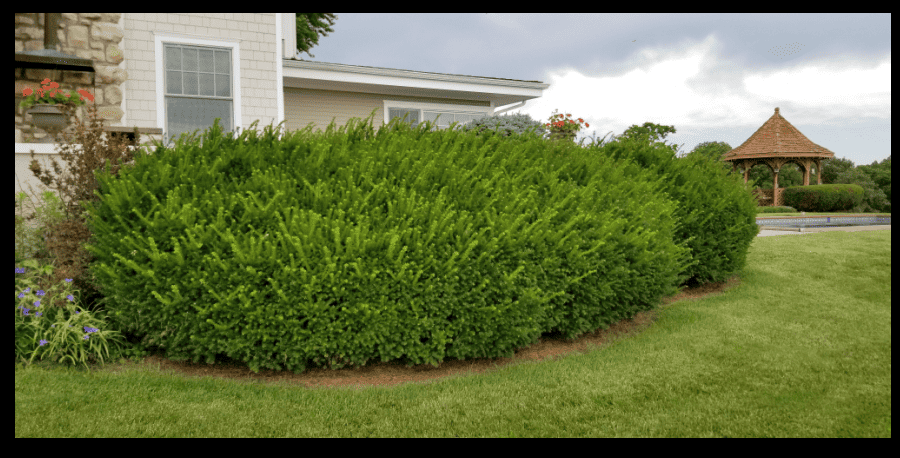
2. Boxwood – Buxus species
For the most part, I do not like boxwood. But that is only because they are overplanted and then sheared into balls which do not match the landscape they are part of. Boxwoods are fairly well adapted to our area, but they are overused. As long as they are placed right, boxwoods can live for several decades in our climate. But stop shearing them into balls! This actually causes more harm than good. If you stick to late fall pruning, and not shearing. Boxwoods are best used for hedges and as centerpieces in the garden.
As a species, there are a few pest problems which are not in our area, but close enough to worry about. Box tree moth and boxwood blight are both close and will kill the plant if left unattended. Actually, there is no cure for boxwood blight, a fungal disease, but there are resistant cultivars.
- ‘NewGen Freedom’ – resistant to boxwood blight and grows 4 to 5 feet tall and wide.
- ‘NewGen Independence’ – is resistant to boxwood blight. It grows 3 to 4 feet tall and wide.
- ‘NewGen Liberty Belle’ – grows 1-2 feet tall by 3 feet wide. It is resistant to boxwood blight.
- ‘Little Missy’ – grows 3 feet tall and wide and is resistant to boxwood blight’

3. Arborvitae – Thuja species
There are quite a few species of arborvitae, also called white cedar. I did not list them among the evergreen trees because they really are not trees. Some grow into large tree-like sizes, and are great for windbreaks, but they are not trees. They have shallower root systems, because they are shrubs. Arborvitaes come in a wide range of sizes and shapes, and even colors. Once established, they are tough and hardy in our region. Some cultivars, however, are not suited for the area, and may be subject to winter scorch or cold damage.
Pests include evergreen bagworm moths and deer browsing. They are an alternate host plant for several rusts, but it does no significant damage.
- ‘Mr. Bowling Ball’ has pale green needles and grows 3 feet tall and wide.
- ‘North Pole’ has dark green needles and grows 10 to 15 feet tall by 3 to 5 feet wide.
- ‘Anna’s Magic Ball’ grows 1 to 2 feet tall and wide with chartreuse-yellow foliage.
- ‘Holmstrup’ grows 5 to 7 feet tall by 2 to 3 feet wide with dark green needles.
- ‘Cheer Drops’ grows 10 to 18 feet tall and wide with lime green foliage.
- ‘Spring Grove’ grows 20 to 30 feet tall by 10 to 12 feet wide with dark green foliage.
- ‘Fire Chief’ has lime green foliage with orange tips and grows 4 feet tall and wide.
- ‘Tater Tot’ grows 1 to 2 feet tall and wide with bright green needles.
- ‘Hetz Midget’ grows 3 to 4 feet tall by 4 to 5 feet wide with dark green foliage.
- ‘Technito’ has dark green needles and grows 6 to 8 feet tall by 2 to 3 feet wide.
- ‘Whipcord’ grows 4 to 5 feet tall and wide with ducky green foliage.

4. Juniper – Juniperus species
Here is another shrub with various species, cultivars, and colors. And some cultivars which mimic trees but are not trees. I am not a fan of junipers, because they are widely overplanted, are an alternative host plant for cedar-quince rust, and are prickly to prune and maintain. But they have good enough qualities to make it to #4 on the list. They are tough and hardy. If we could but get rid of bagworms, then they would be nearly invincible. The only place they will not grow in our region is in wet areas.
Evergreen bagworm moths are about the only insect pest to cause problems. Otherwise, a few root rots and some fungal blights can be an issue, but only in wet areas. High and dry they will grow.
- ‘Calgary Carpet’ has blue-green needles and grows 10 inches tall by 10 feet wide.
- ‘Blue Chip’ has bluish foliage and grows 6 inches tall by 5 feet wide.
- ‘Good Vibrations’ grows 18 inches tall by 9 feet wide with gold foliage.
- ‘Montana Moss’ grows 4 to 5 feet tall by 3 to 4 feet wide with blue-green needles.
- ‘Grey Owl’ has blue-green needles and grows 2 to 3 feet tall by 6 to 8 feet wide.
- ‘Taylor’ grows 10 to 15 feet tall by 3 to5 feet wide with dark green foliage.
- ‘Sea Green’ has bright green needles and grows 4 to 6 feet tall by 6 to 8 feet wide.

5. Globe Blue Spruce – Picea pungens globosa
These are actually a mutation of the Colorado blue spruce which is then grafted onto a trunk of Colorado spruce. Sometimes they are grafted on taller stems to make a “tree” form. Or a lollipop as I call them. Either way, they turn into a large shrub which grows 4 to 8 feet tall and wide, sometimes bigger. The largest I came across was 10 feet tall and 12 feet wide. Just like the tree, they are not really suited for out area. But because this is a shrub form, a life expectancy of 30 to 40 years is fine.
The biggest pest is of course the evergreen bagworm moth, though spruce spider mites can also be an issue. Root rots are not uncommon, but are less of a problem than the trees.

Bottom 5 Evergreen Shrubs
Most of these are on the bottom because they are not as widely planted and therefore less is known about their adaptability to the Central Great Plains region. However, number 10 is my least favorite, for a variety of reasons.
6. Oregon Grape-Holly – Mahonia aquifolium
This is one of my more favorite evergreen shrubs, but it is on the bottom 10 becuase it is hard to find and no one wants to grow it (except me). I do have a few clients with older landscapes that have it in the shade, so it is not unheard of, just uncommon. The leaves are shiny green in summer and reddish green in winter. They are perhaps the shiniest of all the hollies, though they are not a true holly. In the spring, bright yellow flowers erupt from the plants, attracting the bees and butterflies. They prefer some partial shade and grow 3 to 5 feet tall and spread outward 6 to 10 feet.
They have no major pests in our area.

7. Falsecypress – Chamaecyparis pisifera
The falsecypress feels like a juniper but looks like an arborvitae. As far as growing conditions, their needs are similar to arborvitae. They prefer to be out of the wind however, and in some shade at least. They tend to be kinds weeping or droopy in form, and there are several cultivars available.
Winter and summer scorch is its biggest problem while evergreen bagworm moths can kill it if left.
- ‘Gold Mop’ grows 3 to 5 feet tall and wide with golden foliage.
- ‘Soft Serve’ grows 6 to 10 feet tall and wide with gold foliage.

8. Dwarf Spruce – Picea pumila
Dwarf spruce is actually fairly tough. Partly because it is a very low growing evergreen shrub. It only grows 3 to 4 feet tall and wide. And the only reason it in so low on the list is because it has no cultivars. It is basically a dwarf Norway spruce in a ball form. If there were some more cultivars of it with other color variations or textures, like arborvitae or juniper, it would be a top 5 plant.
It has the same problems as Norway Spruce.

9. Mugo Pine – Pinus mugo var. pumillo
The mugo pine is a small, shrub pine which grows 3 to 10 feet tall and wide. There are about 3 cultivars which grow in various sizes. But they all have the same shape. Mugo pine is a decent landscape plant, but it can have an issue with insects and disease. I do not like to use it because of the needle mess it makes, and the sticky sap which is a problem when pruning. Yes, the some of the others are sappy, but pines are worse than any others.
Pests include oystershell scale and pine needle scale, primarily. There are also various sawflies which can affect pines. This pine is also subject to pine wilt disease, though it is rare in the shrub pines.
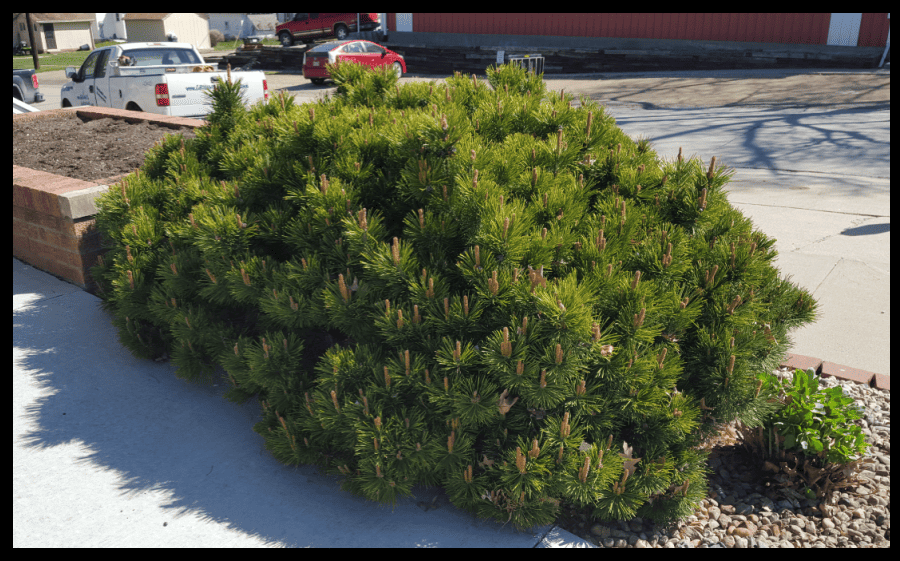
10. Dwarf Alberta Spruce – Picea glauca conica
About the only good thing I have to say about this evergreen shrub is that it needs no pruning and has a nice shape as it grows. Otherwise, I am not a fan. Because of the dense needles, pests can be an issue. And it is such a slow grower. They reach 8 to 10 feet tall and 4 to 6 feet wide, but it only grows 1 to 2 inches per year. Getting them established has also proven to be a problem.
Pests include spruce spider mites, two-spotted spider mites, and bagworms. Root rots and other fungal diseases can be an issue as well.

Conclusion
There are many different types of evergreen trees and shrubs fit for the landscape in the Central Great Plains region. And sometimes there are new things to try, if you have the microclimate to be able to. Use evergreens as specimens, for windbreaks, and to help soften the brown winter landscape with green and gold and blue.
Happy planting!
